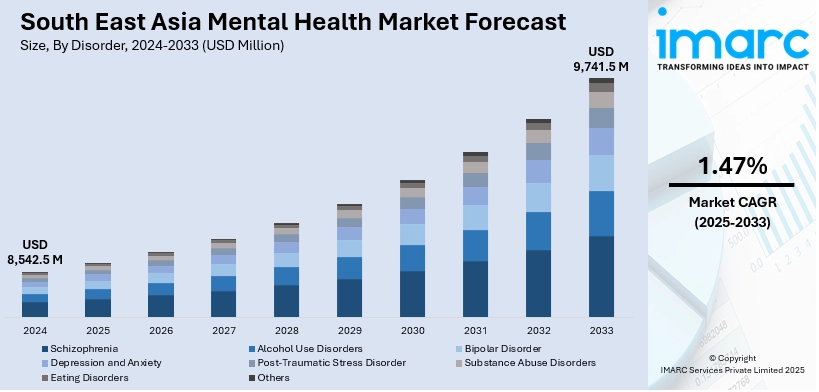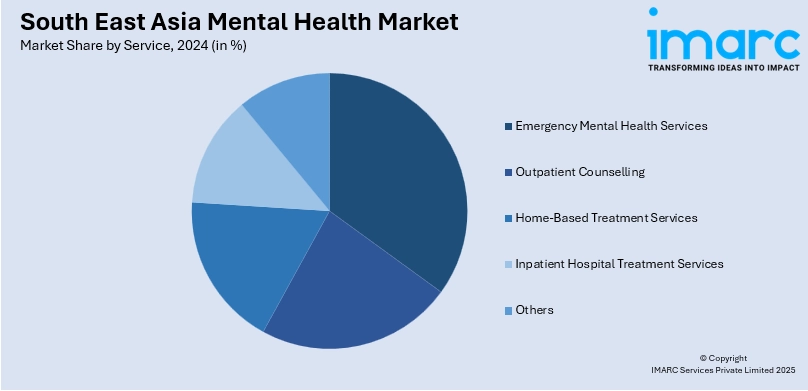
South East Asia Mental Health Market Size, Share, Trends and Forecast by Disorder, Service, Age Group, and Country, 2025-2033
Market Overview:
South East Asia mental health market size reached USD 8,542.5 Million in 2024. Looking forward, IMARC Group expects the market to reach USD 9,741.5 Million by 2033, exhibiting a growth rate (CAGR) of 1.47% during 2025-2033. The rise of telemedicine and mobile health applications, the recognition of the economic impact of mental health on productivity and employee retention and the growing incidence of mental health issues represent some of the key factors driving the market.
|
Report Attribute
|
Key Statistics
|
|---|---|
|
Base Year
|
2024 |
|
Forecast Years
|
2025-2033
|
|
Historical Years
|
2019-2024
|
| Market Size in 2024 | USD 8,542.5 Million |
| Market Forecast in 2033 | USD 9,741.5 Million |
| Market Growth Rate (2025-2033) | 1.47% |
Mental health, a vital aspect of overall wellness, refers to the state of one's emotional, psychological, and social well-being. It encompasses the ability to manage stress, make decisions, and form healthy relationships. In the broad spectrum of mental health care, services range from counseling and psychiatric therapies to digital wellness applications and support groups. These services are designed to address various mental health conditions, such as depression, anxiety, mood disorders, and severe mental illnesses such as schizophrenia. The products within this domain include pharmaceuticals, ranging from antidepressants to mood stabilizers, and non-pharmaceutical interventions such as mindfulness apps and cognitive behavioral tools. The advantages of a robust mental health care system are multifold, impacting not only individual well-being but also societal productivity and economic health. Effective mental health care can reduce the overall burden on healthcare systems, improve workforce productivity, and enhance the quality of life. Additionally, the evolving understanding of mental health is leading to a more holistic approach, integrating physical and mental well-being, further emphasizing the importance of mental health services in a comprehensive healthcare system. The mental health market, therefore, represents a healthcare priority and a significant economic and social opportunity, with its various range of products and services catering to a wide spectrum of needs.

To get more information on this market, Request Sample
South East Asia Mental Health Market Trends:
The mental health market in South East Asia is expanding rapidly, propelled by urbanization and the associated lifestyle changes, which is resulting in an increased awareness and incidence of mental health issues. This region is experiencing a paradigm shift in the perception of mental health, with destigmatization efforts and increased public awareness campaigns significantly contributing to this change. Along with this, governments in South East Asia are increasingly recognizing the importance of mental health, resulting in enhanced policy support and funding for mental health initiatives. In addition, the rise of telemedicine and mobile health applications is making mental health services more accessible, particularly in remote and underserved areas. In addition, the COVID-19 pandemic is acting as a catalyst, bringing mental health to the forefront as individuals grapple with the psychological impact of the crisis. This is influencing innovation in digital mental health solutions, with a notable increase in online counseling services and mental health apps. Moreover, the growing emphasis on workplace mental health, with corporations increasingly investing in employee well-being programs, is favoring the market. This trend is a response to the growing need and a reflection of the recognition of the economic impact of mental health on productivity and employee retention. These factors, combined with a growing middle class and increased healthcare expenditure, are creating a positive market outlook.
South East Asia Mental Health Market Segmentation:
IMARC Group provides an analysis of the key trends in each segment of the market, along with forecasts at the regional and country levels for 2025-2033. Our report has categorized the market based on disorder, service, and age group.
Disorder Insights:
- Schizophrenia
- Alcohol Use Disorders
- Bipolar Disorder
- Depression and Anxiety
- Post-Traumatic Stress Disorder
- Substance Abuse Disorders
- Eating Disorders
- Others
The report has provided a detailed breakup and analysis of the market based on the disorder. This includes schizophrenia, alcohol use disorders, bipolar disorder, depression and anxiety, post-traumatic stress disorder, substance abuse disorders, eating disorders, and others.
Service Insights:

- Emergency Mental Health Services
- Outpatient Counselling
- Home-Based Treatment Services
- Inpatient Hospital Treatment Services
- Others
A detailed breakup and analysis of the market based on the service have also been provided in the report. This includes emergency mental health services, outpatient counselling, home-based treatment services, inpatient hospital treatment services, and others.
Age Group Insights:
- Pediatric
- Adult
- Geriatric
The report has provided a detailed breakup and analysis of the market based on the age group. This includes pediatric, adult, and geriatric.
Country Insights:
- Indonesia
- Thailand
- Singapore
- Philippines
- Vietnam
- Malaysia
- Others
The report has also provided a comprehensive analysis of all the major regional markets, which include Indonesia, Thailand, Singapore, Philippines, Vietnam, Malaysia, and Others.
Competitive Landscape:
The market research report has also provided a comprehensive analysis of the competitive landscape in the market. Competitive analysis such as market structure, key player positioning, top winning strategies, competitive dashboard, and company evaluation quadrant has been covered in the report. Also, detailed profiles of all major companies have been provided.
South East Asia Mental Health Market Report Coverage:
| Report Features | Details |
|---|---|
| Base Year of the Analysis | 2024 |
| Historical Period | 2019-2024 |
| Forecast Period | 2025-2033 |
| Units | Million USD |
| Scope of the Report | Exploration of Historical and Forecast Trends, Industry Catalysts and Challenges, Segment-Wise Historical and Predictive Market Assessment:
|
| Disorders Covered | Schizophrenia, Alcohol Use Disorders, Bipolar Disorder, Depression and Anxiety, Post-Traumatic Stress Disorder, Substance Abuse Disorders, Eating Disorders, Others |
| Services Covered | Emergency Mental Health Services, Outpatient Counselling, Home-Based Treatment Services, Inpatient Hospital Treatment Services, Others |
| Age Groups Covered | Pediatric, Adult, Geriatric |
| Countries Covered | Indonesia, Thailand, Singapore, Philippines, Vietnam, Malaysia, Others |
| Customization Scope | 10% Free Customization |
| Post-Sale Analyst Support | 10-12 Weeks |
| Delivery Format | PDF and Excel through Email (We can also provide the editable version of the report in PPT/Word format on special request) |
Key Benefits for Stakeholders:
- IMARC’s industry report offers a comprehensive quantitative analysis of various market segments, historical and current market trends, market forecasts, and dynamics of the South East Asia mental health market from 2019-2033.
- The research report provides the latest information on the market drivers, challenges, and opportunities in the South East Asia mental health market.
- Porter's five forces analysis assist stakeholders in assessing the impact of new entrants, competitive rivalry, supplier power, buyer power, and the threat of substitution. It helps stakeholders to analyze the level of competition within the South East Asia mental health industry and its attractiveness.
- Competitive landscape allows stakeholders to understand their competitive environment and provides an insight into the current positions of key players in the market.
Key Questions Answered in This Report
The mental health market in South East Asia was valued at USD 8,542.5 Million in 2024.
In South East Asia, the market is experiencing expansion, driven by rising awareness about mental well-being, increasing stress levels due to urbanization and work-related pressures, and greater acceptance of mental health discussions. A shortage of mental health professionals has further created opportunities for online services and mental wellness apps. Moreover, the growing educational and workplace initiatives aimed at reducing stigma and promoting psychological health are supporting the market growth across the region.
The South East Asia mental health market is projected to exhibit a CAGR of 1.47% during 2025-2033, reaching a value of USD 9,741.5 Million by 2033.
Need more help?
- Speak to our experienced analysts for insights on the current market scenarios.
- Include additional segments and countries to customize the report as per your requirement.
- Gain an unparalleled competitive advantage in your domain by understanding how to utilize the report and positively impacting your operations and revenue.
- For further assistance, please connect with our analysts.
 Request Customization
Request Customization
 Speak to an Analyst
Speak to an Analyst
 Request Brochure
Request Brochure
 Inquire Before Buying
Inquire Before Buying




.webp)




.webp)












